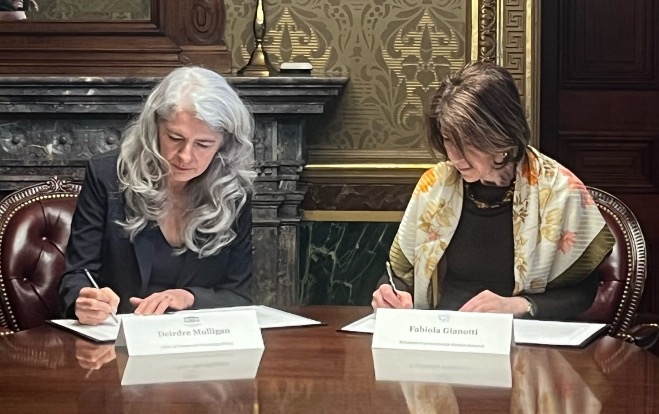CERN and the US sign joint statement of intent

CERN and the US government have released a joint statement concerning future planning for large research infrastructures, advanced scientific computing and open science. The Joint Statement of Intent was signed in Washington DC in April by CERN Director-General, Fabiola Gianotti, and Principal Deputy US Chief Technology Officer, Deirdre Mulligan, of the White House Office of Science and Technology (pictured).
Acknowledging their longstanding partnership in nuclear and particle physics, CERN and the US intend to enhance collaboration in planning activities for large-scale, resource-intensive facilities with the goal of providing a sustainable and responsible pathway for the peaceful use of future accelerator technologies.
Concerning the proposed Future Circular Collider, FCC-ee, which would collide electrons and positrons to produce copious quantities of Higgs bosons, the text states: “Should the CERN Member States determine the FCC-ee is likely to be CERN’s next world-leading research facility following the high-luminosity Large Hadron Collider, the United States intends to collaborate on its construction and physics exploitation, subject to appropriate domestic approvals.” A technical and financial feasibility study for the proposed FCC is due to be completed in March 2025.
CERN and the US also intend to discuss potential collaboration on pilot projects to incorporate new analytics techniques and tools such as AI into particle physics research at scale and affirm their collective mission “to take swift strategic action that leads to accelerating widespread adoption of equitable open research, science, and scholarship throughout the world”.
In December 2023, the high-energy physics advisory panel to the US Department of Energy and the National Science Foundation released a 10-year strategic plan for US particle physics. Meanwhile, the next update of the European Strategy for Particle Physics, which is formed through a broad consultation of the particle physics community in Europe and beyond, is about to get under way. The CERN Council has set the deadline for submitting written input for the next Strategy update at 31 March 2025, with a view to concluding the process in June 2026. The final report of the FCC Feasibility Study will be a key component of that input.
ndinmore



